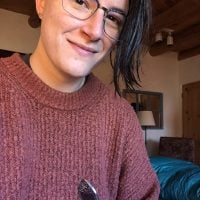While to some nonbinary & transgender identities seem new, they are in fact ancient facets of human experience dating back thousands of years. There are records of indigenous peoples all over the world who currently, or formerly, acknowledged (and revered!) people who were not simply male or female. In many cultures, these gender-diverse individuals were held in high esteem, and were seen as having strong connections to the spirit world due to their innate understanding of both masculinity and femininity. Many held respected positions in society, including shamans, storytellers, warriors, and respected elders.
Here are just a few of the societies we know recognized more than two genders, in the past and in the present:
1. Hijra, South Asia
The Hijra of India, Pakistan, and Bangladesh are a distinct third gender of physiological males who take on feminine appearance, identity, and gender roles. According to PBS’s Map of Gender Diverse Cultures, “in India per Hindu mythology, hijras represent the half-male, half-female image of Shiva.” Their existence is recorded as far back as the Mughal Empire (1500s-1800s), and while hijras still exist, they are pushed to the margins of society due to England’s attempt to eradicate them as “a breach of public decency.” The ongoing impact of colonization on LGBTQ+ people cannot be overstated.
2. Judaism, Diaspora
Judaism is an ethnoreligion that has maintained its culture, language, and religious values over 2,000+ years ofpersecution & oppression. It might surprise some to know that Judaism recognizes 8 genders and has done so for millennia. In the Talmud, there exist male & female, tumtum & androgynos (intersex people), saris hamah (assigned male at birth but later naturally develop female characteristics), saris adam (assigned male at birth but later develop female characteristics through human intervention), and aylonit hamah (assigned female at birth but later naturally develop male characteristics), and aylonit adam (assigned female at birth but later develop male characteristics through human intervention).
Some Jewish scholars even understand the first human, Adam, to have been nonbinary.
3. Muxes, Mexico
Muxes are a third gender recognized by the Zapotec indigenous people of Oaxaca, in southern Mexico. Muxes are people who are assigned male at birth but who eventually present in typically feminine ways through their gender presentation and professions. Many are skilled in embroidery or other artisanal crafts that drive the region’s economy. According to CNN, “even the Zapotec language is accommodating – it has no grammatical gender, only one form for all people.”
4. Ninauposkitzipxpe (Blackfoot Confederacy), Canada
Prior to colonization, the Blackfoot Confederacy in northern Montana and Southern Alberta, Canada recognized a third gender called Ninauposkitzipxpe in the local language, the translation of which is “woman with a man’s heart.” These people were females who did not always dress as men, but they were allowed to take up privileges of men in the society.
5. Mahu, Hawaii
Long before colonization, gender diverse traditions existed among the Kanaka Maoli indigenous group of Hawaii. The mahu were/are people who embody a gender role somewhere between or encompassing both feminine and masculine. They are seen as sacred educators, healers and storytellers of ancient rituals. The colonization of Hawaii nearly decimated the mahu ideology, as native Hawaiians were forced to take up European and American values, including a strict gender binary. Today, mahu continue to face persecution.
6. Dogon Tribe, Mali
The Dogon of Mali see the perfect human as being androgynous. The following is from “The Splendor Gender Non-Conformity In Africa”:
“The tribe worships Nommo, ancestral spirits who are described as androgynous, intersex, and mystical creatures….The existence of intersex spiritual deities laid the foundation for the acceptance of transgender behaviors for other African tribes in addition to the Dogon:
‘African spiritual beliefs in intersexual deities and sex/gender transformation among their followers have been documented among the Akan, Ambo-Kwanyama, Bobo, Chokwe, Dahomeans (of Benin), Bambara, Etik, Handa, Humbe, Hunde, Ibo, Jukun, Kimbundu, Konso, Kunama, Lamba, Lango, Luba, Lulua, Nuba, Ovimbundu, Rundi, Shona-Karonga, Venda, Vili-Kongo, and Yoruba. Transgender in religious ceremony is still reported in the twentieth century in West Africa. And cross-dressing is a feature of modern Brazilian and Haitian ceremonies derived from West African religions.'”
7. Bakla, The Philippines
According to PBS’s Map of Gender Diverse Cultures: “Bakla is a Tagalog term that encompasses an array of sexual and gender identities, but especially indicated a male-born person who assumes the dress, mannerisms, and social roles of a woman. While bakla have existed as a recognized third gender for centuries, more conservative influences in recent decades has marginalized them.
The bakla actually developed their own language to use with each other, called swardspeak. It is a mixture of Filipino, English and Spanish and is spoken with a ‘hyperfeminized inflection’.”
8. Mamluk Sultanate, Egypt
During the Mamluk Sultanate (1200s-1700s) in Egypt, “masculine children who were assigned female at birth could be raised as men.”
9. Wakatane and Whakawahine, New Zealand
In Maori culture, wakatane are people assigned female at birth who take up societal roles traditionally assigned to men, such as manual labor or becoming a warrior. Wakawahine, on the other hand, are men who tend to prefer the company of women and take up societal roles traditionally assigned to women, such as weaving.
Nonbinary and trans people are not new. In fact they are ancient. What is new is the legal standing they have gained to exist without persecution in places that have previously enforced gender conformity and heterosexuality through prejudice, discrimination, and outright violence. We must fight back against those who aim to demonize and dehumanize their existence & expression.






Read 0 comments and reply